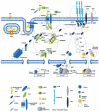Wnt/beta-catenin signaling and small molecule inhibitors - PubMed (original) (raw)
Review
Wnt/beta-catenin signaling and small molecule inhibitors
Andrey Voronkov et al. Curr Pharm Des. 2013.
Free PMC article
Abstract
Wnt/β-catenin signaling is a branch of a functional network that dates back to the first metazoans and it is involved in a broad range of biological systems including stem cells, embryonic development and adult organs. Deregulation of components involved in Wnt/β-catenin signaling has been implicated in a wide spectrum of diseases including a number of cancers and degenerative diseases. The key mediator of Wnt signaling, β-catenin, serves several cellular functions. It functions in a dynamic mode at multiple cellular locations, including the plasma membrane, where β-catenin contributes to the stabilization of intercellular adhesive complexes, the cytoplasm where β-catenin levels are regulated and the nucleus where β-catenin is involved in transcriptional regulation and chromatin interactions. Central effectors of β-catenin levels are a family of cysteine-rich secreted glycoproteins, known as Wnt morphogens. Through the LRP5/6-Frizzled receptor complex, Wnts regulate the location and activity of the destruction complex and consequently intracellular β- catenin levels. However, β-catenin levels and their effects on transcriptional programs are also influenced by multiple other factors including hypoxia, inflammation, hepatocyte growth factor-mediated signaling, and the cell adhesion molecule E-cadherin. The broad implications of Wnt/β-catenin signaling in development, in the adult body and in disease render the pathway a prime target for pharmacological research and development. The intricate regulation of β-catenin at its various locations provides alternative points for therapeutic interventions.
Figures
Fig. (1)
Simplified schematic representation of drug targets (yellow stars) in Wnt/β-catenin-mediated signaling. Four key aspects that regulate β-catenin-mediated signaling are highlighted: the destruction complex, the Wnt/β-catenin signalosome, cadherin junctions, and the hypoxia sensing system Hif-1α (hipoxia induced factor 1β). Proteins that directly interact with Wnt/β-catenin are marked as colored structures, other proteins are marked as circles.
Similar articles
- The Integrated Role of Wnt/β-Catenin, N-Glycosylation, and E-Cadherin-Mediated Adhesion in Network Dynamics.
Vargas DA, Sun M, Sadykov K, Kukuruzinska MA, Zaman MH. Vargas DA, et al. PLoS Comput Biol. 2016 Jul 18;12(7):e1005007. doi: 10.1371/journal.pcbi.1005007. eCollection 2016 Jul. PLoS Comput Biol. 2016. PMID: 27427963 Free PMC article. - The β-catenin/TCF complex as a novel target of resveratrol in the Wnt/β-catenin signaling pathway.
Chen HJ, Hsu LS, Shia YT, Lin MW, Lin CM. Chen HJ, et al. Biochem Pharmacol. 2012 Nov 1;84(9):1143-53. doi: 10.1016/j.bcp.2012.08.011. Epub 2012 Aug 19. Biochem Pharmacol. 2012. PMID: 22935447 - Opposing Roles of Wnt Inhibitors IGFBP-4 and Dkk1 in Cardiac Ischemia by Differential Targeting of LRP5/6 and β-catenin.
Wo D, Peng J, Ren DN, Qiu L, Chen J, Zhu Y, Yan Y, Yan H, Wu J, Ma E, Zhong TP, Chen Y, Liu Z, Liu S, Ao L, Liu Z, Jiang C, Peng J, Zou Y, Qian Q, Zhu W. Wo D, et al. Circulation. 2016 Dec 13;134(24):1991-2007. doi: 10.1161/CIRCULATIONAHA.116.024441. Epub 2016 Nov 1. Circulation. 2016. PMID: 27803037 - Intracellular Signals Activated by Canonical Wnt Ligands Independent of GSK3 Inhibition and β-Catenin Stabilization.
García de Herreros A, Duñach M. García de Herreros A, et al. Cells. 2019 Sep 25;8(10):1148. doi: 10.3390/cells8101148. Cells. 2019. PMID: 31557964 Free PMC article. Review. - LRPs in WNT Signalling.
Davidson G. Davidson G. Handb Exp Pharmacol. 2021;269:45-73. doi: 10.1007/164_2021_526. Handb Exp Pharmacol. 2021. PMID: 34490514 Review.
Cited by
- Differential gene methylation patterns in cancerous and non‑cancerous cells.
Kamińska K, Białkowska A, Kowalewski J, Huang S, Lewandowska MA. Kamińska K, et al. Oncol Rep. 2019 Jul;42(1):43-54. doi: 10.3892/or.2019.7159. Epub 2019 May 15. Oncol Rep. 2019. PMID: 31115550 Free PMC article. - Tankyrase inhibition sensitizes melanoma to PD-1 immune checkpoint blockade in syngeneic mouse models.
Waaler J, Mygland L, Tveita A, Strand MF, Solberg NT, Olsen PA, Aizenshtadt A, Fauskanger M, Lund K, Brinch SA, Lycke M, Dybing E, Nygaard V, Bøe SL, Heintz KM, Hovig E, Hammarström C, Corthay A, Krauss S. Waaler J, et al. Commun Biol. 2020 Apr 24;3(1):196. doi: 10.1038/s42003-020-0916-2. Commun Biol. 2020. PMID: 32332858 Free PMC article. - Isoform-specific GSK3A activity is negatively correlated with human sperm motility.
Freitas MJ, Silva JV, Brothag C, Regadas-Correia B, Fardilha M, Vijayaraghavan S. Freitas MJ, et al. Mol Hum Reprod. 2019 Apr 1;25(4):171-183. doi: 10.1093/molehr/gaz009. Mol Hum Reprod. 2019. PMID: 30824926 Free PMC article. - Crosstalk between long non-coding RNAs and Wnt/β-catenin signalling in cancer.
Yang G, Shen T, Yi X, Zhang Z, Tang C, Wang L, Zhou Y, Zhou W. Yang G, et al. J Cell Mol Med. 2018 Apr;22(4):2062-2070. doi: 10.1111/jcmm.13522. Epub 2018 Feb 1. J Cell Mol Med. 2018. PMID: 29392884 Free PMC article. Review. - Transglutaminase 2 as a novel activator of LRP6/β-catenin signaling.
Deasey S, Nurminsky D, Shanmugasundaram S, Lima F, Nurminskaya M. Deasey S, et al. Cell Signal. 2013 Dec;25(12):2646-51. doi: 10.1016/j.cellsig.2013.08.016. Epub 2013 Aug 29. Cell Signal. 2013. PMID: 23993960 Free PMC article.
References
- Nusse R, Varmus HE. Many tumors induced by the mouse mammary tumor virus contain a provirus integrated in the same region of the host genome. Cell. 1982;31(1):99–109. - PubMed
- McMahon AP, Moon RT. Ectopic expression of the proto-oncogene int-1 in Xenopus embryos leads to duplication of the embryonic axis. Cell. 1989;58(6):1075–1084. - PubMed
- Logan CY, Nusse R. The Wnt signaling pathway in development and disease. Annu Rev Cell Dev Biol. 2004;20:781–810. - PubMed
Publication types
MeSH terms
Substances
LinkOut - more resources
Full Text Sources
Other Literature Sources
